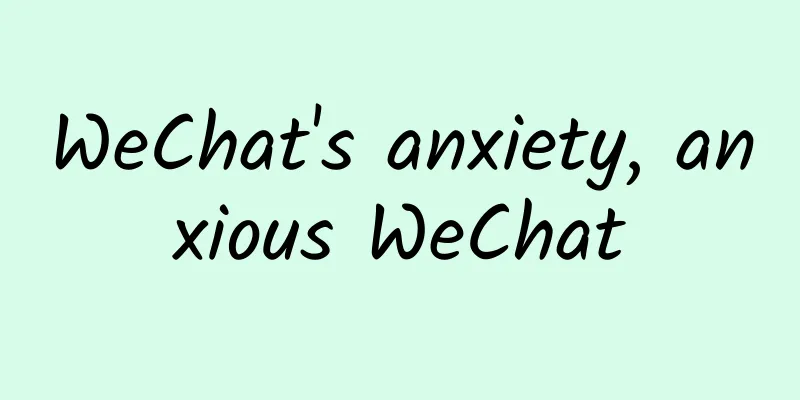WeChat's anxiety, anxious WeChat

|
Key points of this article
Restraint is a label that the outside world has given to WeChat, but this year, the situation seems to be a little different. Wu Ruga, the founder of Knowledge Planet, once posted a message on Moments: "A buddy said: WeChat is full of anxiety pimples, it was not like this before." The accompanying picture was a screenshot of the WeChat discovery page full of red dot reminders. Source: Immediate user wulujia On the small-scale Moments platform, this post received nearly a thousand likes and more than 400 replies, with many users commenting with similar feelings to Wu Ruga. After entering 2020, WeChat has indeed become more active. In the past eight months, WeChat has released major updates almost every month: the number of WeChat friends has exceeded the upper limit of 5,000, new group agents have been added, public account messages support multiple rounds of replies, and the highly anticipated video account has gone from internal testing to full release, all of which appeared in front of users in just these few months. As a national application, any change in WeChat affects the daily lives of many ordinary users, so every move will be pushed under the magnifying glass for inspection. In this regard, Zhang Xiaolong once complained: "Every day, 500 million people in the country complain about WeChat, and 100 million people teach me how to make products." This self-awareness made WeChat extremely cautious in the early years. For example, the 5,000-friend limit that was introduced at the beginning of the year was not a new topic, and related discussions had already appeared, but the 5,000 limit was not broken until this year. In January 2016, Zhang Xiaolong unexpectedly showed up at the WeChat Open Class PRO event held in Guangzhou and shared four values. Among them, the idea that a good product should be used and discarded sparked heated discussion. But now, WeChat increasingly hopes that users will stay more within the WeChat system. Whether it is the newly launched video account or the previously launched "Look", their product forms are not completely consistent with the value of use it and leave. Over the past few years, from setting red lines to breaking red lines, WeChat's thinking and attitude have undergone subtle changes. Split Use and Go On January 22 this year, 13 days after Zhang Xiaolong announced that "WeChat has been exploring short content", WeChat officially announced that "WeChat Video Account has started internal testing." At that time, with the confirmation of human-to-human transmission of the new coronavirus sounding the alarm for the epidemic, the attention received by Video Account was far less than the high expectations when the Mini Program was launched. However, WeChat's attention to this new product has not diminished in the slightest. One detail that can prove this is that in the early stage of the internal testing of Video Account, in addition to many WeChat employees taking the initiative to send internal testing invitations to their friends, Zhang Xiaolong also personally took action and coordinated with Tencent's internal resources to invite a group of celebrities to join, including Yang Chaoyue, Wan Qian and others. It is not difficult to understand why Video Account is so well received. On the one hand, in the 2020 WeChat Open Course PRO version, Zhang Xiaolong has clearly stated that "compared to the official account, we lack a carrier that everyone can create", and the mission of Video Account is to help WeChat make up for the regret. On the other hand, in the short video wave set off by Douyin and Kuaishou, Tencent must create a fist product to resist external enemies. The internal testing of the video account kicked off a busy year for WeChat in 2020. Except for February, when the epidemic prevention and control was the most stringent, WeChat has made significant moves at other times. According to incomplete statistics, WeChat has made the following updates this year:
It can be seen that compared with previous changes, WeChat has indeed undergone more drastic reforms this year. Overall, the many updates of WeChat this year can be classified into two categories: One is tool optimization, which, based on WeChat’s positioning as a social tool, continuously optimizes the social and information acquisition experience, as well as optimizes the operational convenience of official accounts and mini-programs for operators or developers. The other type is to add more functions to WeChat to provide users with more options to "kill time"; and provide larger traffic entrances for segmented modules, such as opening the gates for sharing mini-programs to Moments, and changing the video account sharing to Moments to large picture mode. The idea of tool optimization is not difficult to understand. Whether it is to refine the management of friend chain relationships, add WeChat group functional components, or improve the operation, sharing, and information collection experience of public accounts, or optimize the use experience of mini programs, the fundamental purpose of these actions is to allow users to use WeChat more smoothly. In other words, their common purpose is to serve the "use it and leave it" concept proposed by Zhang Xiaolong four years ago. Zhang Xiaolong previously explained, "Any product is just a tool. A good tool should accomplish the user's purpose with the highest efficiency and then leave as soon as possible." "The industry is envious of WeChat being a time killer for users, but what we need to consider is how to help users complete tasks more efficiently, rather than letting users always have endless things to do in WeChat." However, the purpose of adding is somewhat vague. For example, the highly valued video account uses the information flow presentation method. After the revision, it pushes popular content in addition to user subscriptions and content displayed based on friend relationships - that is, in addition to the results of user active selection, the system continues to recommend short videos. More modules, more content filled in, consume more time. At the same time, WeChat also marked the video account with a strong reminder sign of a small red dot. All the intentions are to attract users to stay longer in the video account, which is inconsistent with the previous concept of "use it and leave". The once highly praised "use it and leave it" concept has obviously reached a fork in the road. So why did WeChat, which has caused a lot of "acne" on the discovery page, make changes? WeChat's long-term and short-term concerns WeChat, which originated in the mobile Internet era, has grown up amid praise. Compared with the rarely used products in the PC era, WeChat, when it was first launched, quickly captured users with its minimalist interface and operation, and also established a good reputation. In the course of WeChat's growth, voice messaging, shake, Moments, WeChat public platform, and mini-programs are important product nodes for WeChat to continuously conquer the market. Thanks to its early first-mover advantage, the delivery of Tencent's original social relationship chain, and product-level innovation, WeChat has been smooth sailing, gradually expanding its influence from social networking to payment, becoming a "must-have" for users, an important channel connecting online and offline, and one of the "foundations" of Tencent and even the entire Chinese Internet. The sense of security brought by the moat built by the "base" to WeChat reached its peak around 2017. One of the manifestations is that under the dual control of a huge user base and a good brand image, WeChat has become more cautious and restrained. For example, after Zhang Xiaolong announced the new product "App Number" at the WeChat Open Class PRO version in January 2016, it took a year for the WeChat team to officially launch the mini-program, and in the early stages, it adopted very strict control over the internal testing qualifications - which is completely different from the pace and attitude of promoting the video account today. Internally, when the pace of innovation slows down, the atmosphere of doing things and the space for imagination also change. In 2018, many core members of the WeChat team left to start their own businesses and developed new social products such as Echo Moments, POP IM, and Walnut. Among them, the founder of Echo is Huang Tianqing, who was once the director of the Basic Product Center of the WeChat Business Group's Open Platform Basic Department. The Walnut founding team once used cartoons in their WeChat public account to satirize workplace phenomena, making "playing polo" a meme within Tencent. Image source: Pengcha Shiyilang Compared with today's video account products that explore the combination of weak and strong relationships, and the frequent and drastic adjustments to official accounts, most of WeChat's previous actions were more like minor repairs based on existing achievements. However, just as WeChat was entering its comfort zone, the external environment was undergoing drastic changes: relying on the "group buying + low price" model, Pinduoduo, with the help of WeChat, quickly opened up the situation through fission-like social communication and grew into the third pole of China's e-commerce; and through large-scale traffic purchases, brand placement and creative operations, Douyin quickly rose, seized the tail of the mobile Internet dividend, and became the new trump card in ByteDance's hands. More importantly, regardless of whether it is a giant, a newcomer, or a unicorn, the common challenge facing the industry is the gradual decline of the mobile Internet dividend - WeChat's growth curve has flattened since 2018. In the context of the sharp compression of the incremental market space, competing for the existing market - user time has become the common choice of everyone. Under the impact of latecomers, the BAT structure that has been stable for many years has shown signs of loosening. Source: QuestMobile 2020 Mobile Internet Panoramic Ecosystem Report The double whammy of external challenges and internal staff loss has become a near-term worry for WeChat: externally, the fierce competition for user time will inevitably erode WeChat's traffic pool, leaving competitors with weak points for counterattack; internally, when the product cannot find new growth points, the team that was accustomed to rapid development cannot adapt to the slow pace and increasingly narrow room for advancement, and will inevitably be more susceptible to external opportunities, leading to talent loss. The more far-reaching impact is that once other rapidly emerging products restructure users' habits of obtaining information and social entertainment, the migration costs brought by the social relationship chain are likely to be reduced, and WeChat's seemingly solid moat will also face challenges. This is not alarmist. In fact, after establishing a foothold in the industry through Toutiao and Douyin, ByteDance has never stopped exploring social links. Based on its own huge traffic pool, ByteDance has already tried in the fields of games and education. This is not fundamentally different from the logic of WeChat opening up an entrance for Tencent's games and other products, but the implementation path is different. In the face of long-term and short-term concerns, WeChat must make changes. Since 2019, there have been frequent updates on WeChat products such as official accounts and live broadcasts. In the 2020 WeChat Open Course PRO version, Zhang Xiaolong once again sorted out and summarized his thoughts on products. Compared with four years ago, this time the thinking is more practical. Subsequently, related explorations were quickly implemented, forming the perception that WeChat was frequently updated in 2020. Compared with the previous minor repairs, many of the attempts made by WeChat now need to think about the original red line issues. The existing accumulation has given WeChat enough room for experimentation, but it also brings more constraints. "Shen Xiang" once mentioned in an article on WeChat Video Account that there is no successful case to follow in the practice of satisfying both strong and weak relationship social needs in one product. But for WeChat, such a risk is a necessary choice. More importantly, after latecomers have redefined the underlying logic and user experience of information acquisition and recommendation, how to improve the efficiency and perception of "connection" based on its own advantages is the biggest challenge facing WeChat. Video accounts and the series of updates since this year are the beginning of a new journey for WeChat. Regardless of the outcome of the attempt, a WeChat that is willing to try to break out of its comfort zone is at least more interesting than an overly cautious WeChat. |
<<: Top 10 Flutter and React Native UI Libraries for 2020
>>: WeChat Pay adds "travel services": refueling is more convenient and you can compare prices
Recommend
30% conversion rate, educational community conversion skills!
2019 can be regarded as the first year of communi...
How does an information flow optimizer who earns 20,000 yuan a month manage an account?
Today's content is a bit dry and a bit long, ...
Building your first Swift blockchain application
As a revolutionary technology, blockchain is gain...
Data | Online advertising revenue exceeded 67 billion in Q2 2016, data drives advertising value increase!
Overview of Internet Advertising Development in Q2...
iFixit shares iPhone 13 Pro disassembly report: repairability is only 5/10 points
iFixit has just shared a teardown report of the i...
How to write a marketing plan that satisfies your boss?
At the beginning of the year, all major companies...
Growth Hacker's Guide: How to Improve User Retention
If you still invest huge budgets to attract new c...
APP operation indicators and promotion and marketing suggestions!
How to do a good job in App operation and promoti...
How much does bidding hosting cost, and is it charged annually or monthly?
1. Batch operations can be performed on keywords,...
Some are happy, some are sad, there are big winners on 315, 3 mobile phone manufacturers do a good job in privacy protection
Every year, March 15 becomes a nightmare for busi...
Why does ofo invest in advertising while Mobike does public relations?
To date, ofo and Mobike have been fighting for ne...
Marketing strategy and distribution system design!
1. Introduction: What is distribution? Where does...
4 analysis models for high-conversion products!
Today, I would like to talk to you about the issu...
Practical review: How to build a complete operation system?
This article is a review of my recent practice. T...
JD.com e-commerce operation traffic logic
1. Top-level structure of traffic logic 1. Accura...









